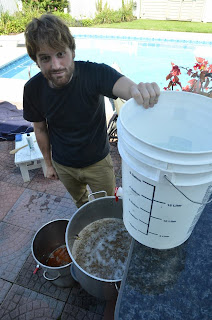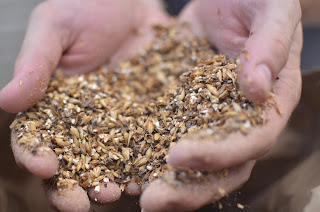Wow, it has been a while. A lot has gone on, and my lack of updates has been due to equal parts of a new xbox game, visiting good friends, as well as my aversion to having to write a really long post. I finally managed to get myself on it tonight, since there is only more beer coming, of which must be written. This isn't the lightest reading, so I should keep it as short as I can...
 |
| Enjoying autumn amidst canned farmhouse, friends, and nostalgia. I have only brilliant excuses for not writing |
First things first: the Simo. I was pretty damn eager to get
a taste of this one for a while, and finally had my wishes fulfilled last week.
It conditioned for about 3 ½ days in a keg at 30psi (per recommendation—I’m new
to the area of kegging). It worked out damn well, pouring slightly heady-er
than I would have liked. The taste however was phenomenal. Heavy coco/hazelnut
characteristics from the malt, with a fine accompanying hop bite at the end. It
weighed in at about 9.5% and you can sure taste it. There is a bit of a warming
feeling after the second sip (or so),that signals a high ABV, but nothing
offensive.
 |
| Despite what you may think, this is a shot of me at work. |
It’s a
brilliant beer. I’ve gotten loads of compliments on it from everyone that’s
tried it, but it could be heaps better with a bit of aging. So of course, I now
have two 500ml, corked bottles sitting in my cellar. They will be opened for
New Years. As is tradition.
Second up is the Tarakena. This was my first personally-kegged
beer, and I’m decently content with the results. An odd descriptive, I know,
but it really is the only way. This beer is good. The malt profile (to remind,
is a Saison build) is spot on, and the hop additions are perfect. The issue is
that upon first taste, the beer screams BELGIUM. The golden ale yeast was a
hell of a lot more potent than I thought it would be (in retrospect, it’s a
Belgian yeast. That’s like a French recipe in cooking—if it doesn’t floor you
it’s not worth trying). The yeast character completely stole the show from the
chamomile, ginger, and mint. There is a decent orange character in it, however,
which really compliments the NZ hops. The ginger also makes a brief appearance,
but otherwise, one would never know I used chamomile or mint.
 |
| Achievement Unlocked: Color perfection |
I’m really tied, because I like the golden ale yeast flavor,
but need it to be subtler. The ABV is moderate (about 6.4%), so I don’t want to
short the amount of yeast pitched, and so I believe the solution is to change
the yeast (which I’d be somewhat alright with) or to increase the mint and
chamomile. Its really looking like I’ll have to do an experiment with this one,
and do a split batch with both options to see what works best. It has a hell of
a lot of potential, and so I would love to get this one down to
near-perfection.
Now that the tastings have been covered, it’s time to move
onto what’s still fermenting. I’m going to cheat a bit, however, since the
first beer I’m covering is now in a keg. The Smoked Weizenbock(WB) is a
troubling beast. I’m concerned because I had high hopes for this one and it has
been—nearly—my Titanic. While the fermentation seemed fairly vigorous, it only
dropped the gravity by a miniscule amount. Going into secondary it was only
1.042…
To make matters worse, I completely overlooked my
fermentation set up. When I racked the WB into the secondary, I realized that I
didn’t have a stopper for the damn thing. Amidst my panic I used some plastic
wrap and a rubber band to ‘seal’ the opening—a strategy I picked up from some
book I read somewhere along the line for making yeast starters. I kicked myself
all day and made sure to get a proper seal as soon as I finished work the
following day.
 |
| Low gravity, but promising taste. Why you gotta play me, Weizenbock? |
I’m remaining optimistic however. It was only a jerry-rigged
airlock for less than 24 hours, and upon tasting the into-keg-product today I
didn’t get any signs of an infection. I am wary, however, about what I put into
that keg. The gravity didn’t change from 1.042, so the ABV is roughly 5.4%—much
lower than I wanted. I’m not entirely sure as to why it crapped out on me, but
after reading Dave’s contribution, the issue may have been my general ignorance
to the particular yeast. Perhaps I should have added more to the fermenter—the
yeast presence is very subtle-to-nonexistent.
On the positive side, though, the malt profile is a thing of
beauty. It has a dark fruit/date/sweetness to it, and a nice bitter bite that’s
about half malt-based, half hop-based.
 |
| If you look closely, you can see bits of my perfectionism floating to the bottom...with my dreams |
In addition, the level of smoke in the beer is spot on. I’m
glad I showed some restraint in that area, because it is quite literally on the
line of being too much for liberal WB interpretation. Overall, I think that as
long as the lower ABV gets forgiven (and there is still no infection: fingers
crossed), it could be an appreciated take on an already enjoyable style.
The other fermenter, of course, contains the pumpkin ale.
I’m fairly certain that this recipe is flawless, because goddamn, I think
Shiggy and I are going 3 for 3 on medals for this sonofabitch. Transferring
into a secondary, the gravity was perfection: 1.012. At 5.5%, it’s a pumpkin
ale that won’t put you on your ass, yet is still enjoyable. And tasty it is! My
nip from the transfer was heaven. I would drink this beer uncarbonated. The
dropping of the clove and cutting back on some of the spices helped immensely,
especially with increasing the amount of pumpkin. Uncarbonated, the beer tastes
thick, rich, subtly spiced, and frankly, bitchin. It will be going into the keg
tomorrow (after bottling the remaining Tarakena).
Phew, what a lot to catch up on. Now onto the new things, as
well as planned ventures! I weighed out the remaining Serebrianka hops the
other week, and realized I had roughly 350g left….single hop IPA? Yes. I
thought I could also sneak in some research for a future recipe and used a
theoretical malt profile I had been planning. It consists of Maris Otter,
Victory, and Crystal 60 (in decreasing % order). I did the same hopping
technique used for the Cascadian Ancestral, but kept it around a total of 60ish
IBU’s (following my only reference of 8Wired’s Tall Poppy…) I used the American
ale yeast blend, and HO-LY-SHIT does that yeast work! 22L is currently still
fermenting heavily—after a week and a half—with an OG of 1.066. I plan on
transferring it to a secondary when it calms down a bit more, which it does
seem to be slowing. I’m taking my time with this one, though, because I may
have found the yeast/malt build for my Fenrir…
The only other thought that I had in regards to a Fenrir
build occurred during my visit to Café Bruges today. They stock a new beer
called the Svea IPA, which was damn good. What interested me most about it was
the malt profile. They used everything. Barley, oats, wheat, and rye…it made me
think. My idea of Fenrir is—obviously—something delicious, with some very
specific flavors. But if I could get the same backing that this beer had along
with the creativity of using every brewing grain possible…well that only feeds
the beast more (appropriately so!).
Food for thought.
If you’re still with me, I may as well discuss the next two
recipes in brief. Wheat wine. Round two. This time it will be what I want. I’d
love to get this baby straight into bottles, and age it until new years. Only
issue is—of course—not diluting the fucker again, as well as having it taste
like a wheat wine rather than a hard, hoppy, wheat ale (I like the idea of the
Hard (hugh)Heff, but I want to make reality what I imagine, not settle for
calling screw ups my ‘works of art’).
The other was a recipe that slapped me across the face, and
begged me to make it. Bored at work, I tossed through an ancient beers book and
found a rudimentary recipe for a ‘beer’ called a Gotlandsdricka. With a name
like that, it has to be made. Not to give too much away now, but it’s going to
be smoky, sweet, and use juniper in some pretty awesome ways. It’s recipes like
this that make brewing so much damn fun.
No real meaningful lessons learned for this entry (the WB
will probably have a few once it is in a drinking state…), except for one.
Refrigerators with a two-corni keg-capacity are hard to find, and even harder
to transport in a small car…
Serebrianka Single Hop
Maris Otter, Victory, Crystal 60L
Serebrianka
American Ale Blend (WLP 060)
Serebrianka Single Hop
Maris Otter, Victory, Crystal 60L
Serebrianka
American Ale Blend (WLP 060)











